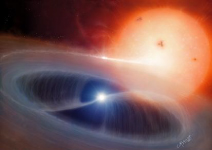DQ Herculis star

DQ Herculis star (intermediate polar)
Image: © Mark A. Garlick / space-art.co.uk.
A DQ Herculis star, also known as an intermediate polar, is a magnetic cataclysmic variable in which the white dwarf component generates a magnetic field on the order of 106 to 107 gauss – extremely powerful but weaker than the field associated with an AM Herculis star. The type star, known by its variable star name of DQ Herculis, lies in the constellation Hercules and was seen in outburst as Nova Herculis 1934.
In a DQ Her system, an accretion disk forms from material stripped from the red dwarf secondary but is disrupted close to the white dwarf primary by this star's magnetic field. As the material in the accretion disk approaches the white dwarf, it is swept up by the magnetic field of the white dwarf to form accretion curtains that follow the magnetic lines of force. The magnetosphere of the white dwarf is tilted with respect to the orbital plane, causing the accretion curtain to split – the material following the shortest route along the magnetosphere. It then crashes onto the magnetic poles of the white dwarf, causing intense emission. Although the white dwarf's magnetosphere is strong, it is not strong enough to synchronize the orbits of the rotating white dwarf with the orbital period of the system as in AM Her stars.


